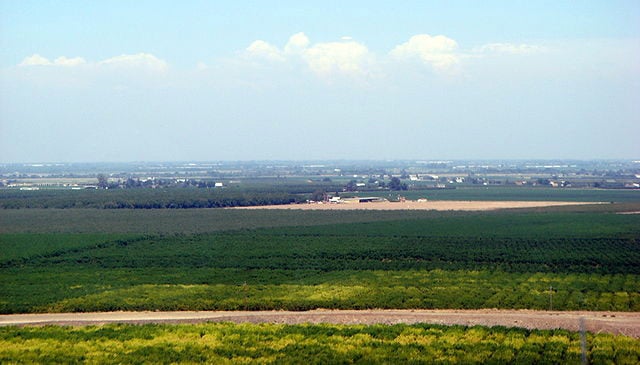In “San Joaquin Valley could meet EPA’s newest ozone standard in 2037, if …” was all about the reduction of ozone in the Valley in terms of meeting the new U.S. Environmental Protection Agency’s (EPA) 8-hour standard of 70 parts per billion (ppb) of air, mainly as it had to do with transportation. As was expressed in that post, “The Valley has until 2037 to meet the standard.”
In the same Dec. 27, 2015 Air Quality Matters post, meanwhile, reference was made to The Fresno Bee op-ed “The age of the all-electric Valley is upon us” and, in reference to that, what was written was, “The Editorial Board of The Fresno Bee … stated that for California’s entire San Joaquin Valley (all 24,000 or so square miles, presumably) to comply with the U.S. Environmental Protection Agency’s (EPA) newest ozone standard – set at 70 parts per billion (ppb) of air (an improvement from the previous standard of 75 ppb) – this will require the whole region, transportation-wise, to become fully ‘electrified’; in essence, apparently, echoing a declaration originally made by the San Joaquin Valley Air Pollution Control District (air district).”
Now, given there was little mention (if that) in the Bee editorial in question of potential ozone reductions from stationary sources and how, in achieving such, this could play into helping meet the federal standard, this seems somewhat remiss especially considering the California Air Pollution Control Officers’ Association (CAPCOA) in its California’s Progress Toward Clean Air report for 2015 in no uncertain terms in the “Executive Summary” section wrote: “Achieving this new standard will require further reductions of smog-forming pollutants on top of regulations that are already among the strictest in the nation. In areas with the highest level of air pollution, including Southern California and the San Joaquin Valley, achieving proposed air quality standards calls for a transformation of our combustion-driven society to zero- and near-zero emission sources of transportation and energy.”1
So, in considering the meeting-the-newest-federal-8-hour-ozone-standard-by-2037 premise in the broader context, to not mention any source other than transportation, in my opinion, seems shortsighted.
Ozone, as a corrosive gas, occurs as a result of the mixing of certain chemicals in the air in the presence of sunlight and heat. According to The Fresno Bee in an aptly named Dec. 16, 2007 special feature titled: Fighting For Air, as so-noted in at least one of a number of articles, in this case, possessing the title: “Clearing the air,” there was mention of hydrocarbons (HC) and oxides of nitrogen (NOx) as being major components contributing to ozone forming in summer.2
It should be noted that eight years ago when this Bee special feature was both published and circulated, and in the aforesaid “Clearing the air” article no less, since the introduction and implementation of new rules in 2002, 45 tons each of HC and NOx had been expunged from the Valley air daily. At the same time it was also offered that to meet a then 2024 target, a further 438 tons daily of NOx alone needed to be eliminated (based on “computer simulations”). Noted in this same Bee article also is that, with respect to NOx emissions, in the neighborhood of 598 tons of the gas was being added to the Valley’s atmosphere daily. And, that was just for NOx which says nothing of the daily contribution of HC.
Moreover, via a detailed graphic (from the same article), presented are the NOx amounts at the time coming from various mobile and stationary sources.
In no particular order the NOx sources and total amounts (in tons per day) are:
- Cars and light trucks = 49
- Farm equipment = 55
- Trains = 25
- Diesel trucks = 237
- Construction and mining equipment = 48
That by itself amounts to 414 tons per day which means there is additional approximately 184 tons per day of NOx emissions coming from one or more other sources – energy production, industry, residential, commercial, what-have-you.
Meanwhile, getting back to the CAPCOA 2015 report, pointed out and on a positive note, “The San Joaquin Valley remains on track to meet the 84 ppb federal 8-hour ozone standard before the deadline (the ‘black box’ plan component is no longer needed). San Joaquin Valley residents’ exposure to ozone concentrations above the health-based standards established by U.S. EPA, including the toughest 8-hour ozone standard, has been reduced significantly. For the three-year period from 2012 through 2014, with a neighborhood-by-neighborhood accounting for population exposure to ozone concentrations, on average, San Joaquin Valley residents were exposed to ozone concentrations for the fewest number of days on record.”3
The big question here though is: What tonnage of ozone will need to be daily taken out of the Valley’s air to comply with the 70 ppb EPA 8-hour standard and what “practical” approaches can be employed to achieve that end? This is what will be explored in “San Joaquin Valley could meet newest ozone standard by 2037, if … 3.”
To be continued.
Notes
- California Air Pollution Control Officers’ Association, California’s Progress Toward Clean Air, 2015, “Executive Summary” section, p. 5
- Fighting For Air, “Clearing the air,” The Fresno Bee, Dec. 16, 2007, p. 12
- California Air Pollution Control Officers’ Association, California’s Progress Toward Clean Air, 2015, “Air District Updates – San Joaquin Valley Air Pollution Control District” section, p. 33
This post was last revised on May 24, 2020 @ 6:45 a.m. Pacific Daylight Time.
– Alan Kandel
